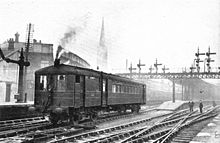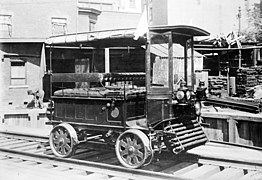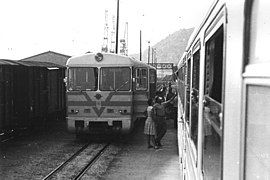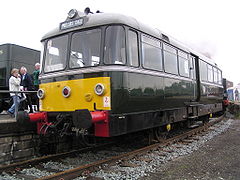Railcar

The Bombardier Talent articulated regional railcar.

The Regio-Shuttle RS1 low-floor vehicle is a modern version of a single unit railcar. Several of these can run together; articulated versions are also available.

A 3-car train of 2000 class railcars in suburban Adelaide, Australia

A 1,520 mm (4 ft 11 27⁄32 in) Russian gauge Latvian RVR-made railbus AR2-002 in Vilnius, Lithuania, still Soviet design
A railcar, in British English and Australian English, is a self-propelled railway vehicle designed to transport passengers. The term "railcar" is usually used in reference to a train consisting of a single coach (carriage, car), with a driver's cab at one or both ends. Some railway companies, such as the Great Western, termed such vehicles "railmotors" (or "rail motors").
Self-propelled passenger vehicles also capable of hauling a train are, in technical rail usage, more usually called "rail motor coaches" or "motor cars" (not to be confused with the motor cars, otherwise known as automobiles, that operate on roads).[1]
The term is sometimes also used as an alternative name for the small types of multiple unit which consist of more than one coach. That is the general usage nowadays in Ireland when referring to any diesel multiple unit (DMU), or in some cases electric multiple unit (EMU).
In North America the term "railcar" has a much broader sense and can be used (as an abbreviated form of "railroad car") to refer to any item of hauled rolling-stock, whether passenger coaches or goods wagons (freight cars).[2][3][4]
In its simplest form, a "railcar" may also be little more than a motorized railway handcar or draisine, otherwise known as a speeder.
Contents
1 Uses
2 Propulsion systems
2.1 Steam
2.2 Petrol
2.3 Diesel
2.4 Electric
2.5 Battery-electric
3 Old-generation railcars
4 New-generation DMU and EMU railcars
4.1 Institutional/regulatory Issues
4.2 Existing systems
4.3 Manufacturers
5 Multiple-unit and articulated railcars
6 Railbuses
6.1 Road-rail vehicles
7 Parry People Movers
8 Draisine
9 See also
9.1 Categories
9.2 General
10 References
11 External links
Uses
Railcars are economic to run for light passenger loads because of their small size, and in many countries are often used to run passenger services on minor railway lines, such as rural railway lines where passenger traffic is sparse, and where the use of a longer train would not be cost effective. A famous example of this in the United States was the Galloping Goose railcars of the Rio Grande Southern Railroad, whose introduction allowed the discontinuance of steam passenger service on the line and prolonged its life considerably.
Railcars have also been employed on premier services. In New Zealand, although railcars were primarily used on regional services, the Blue Streak and Silver Fern railcars were used on the North Island Main Trunk between Wellington and Auckland and offered a higher standard of service than previous carriage trains.
In Australia, the Savannahlander operates a tourist service from the coastal town of Cairns to Forsayth, and Traveltrain operates the Gulflander between Normanton and Croydon in the Gulf Country of northern Queensland.
Propulsion systems
Steam

LNER Sentinel-Cammell steam railcar
William Bridges Adams built steam railcars at Bow, London in the 1840s. Many British railway companies tried steam railcars but they were not very successful and were often replaced by push-pull trains. Sentinel Waggon Works was one British builder of steam railcars.
In Belgium, M. A. Cabany of Mechelen designed steam railcars. His first was built in 1877 and exhibited at a Paris exhibition. This may have been the Exposition Universelle (1878). The steam boiler was supplied by the Boussu Works and there was accommodation for First, Second and Third-class passengers and their luggage. There was also a locker for dogs underneath. Fifteen were built and they worked mainly in the Hainaut and Antwerp districts.
Petrol
In 1904 the Automotor Journal reported that one railway after another had been realising that motor coaches could be used to handle light traffic on their less important lines.[5] The North-Eastern railways had been experimenting “for some time” in this direction, and Wolseley provided them with a flat-four engine capable of up to 100 bhp (75 kW) for this purpose. The engine drove a main dynamo to power two electric drive motors, and a smaller dynamo to charge accumulators to power the interior lighting and allow electric starting of the engine. The controls for the dynamo allowed the coach to be driven from either end. For further details see 1903 Petrol Electric Autocar.
Another early railcar in the UK was designed by James Sidney Drewry and made by the Drewry Car Co. in 1906. In 1908 the manufacture was contracted out to the Birmingham Small Arms Company.
Diesel
While early railcars were propelled by steam, petrol, and diesel engines, modern railcars are usually propelled by a diesel engine mounted underneath the floor of the coach. Diesel railcars may have mechanical (fluid coupling and gearbox), hydraulic (torque converter) or diesel-electric transmission.
Electric
Single electric railcars on mainline electric systems are rare, since electrification normally implies heavy usage where single cars would not be economic. The exceptions to this rule are to be found on tram and interurban systems, the Red Car of the Pacific Electric Railway being an iconic example.
Battery-electric
Experiments with battery-electric railcars were conducted from around 1890 in Belgium, France, Germany and Italy. In the USA, railcars of the Edison-Beach type, with nickel-iron batteries were used from 1911. In New Zealand, a battery-electric Edison railcar operated from 1926 to 1934. The Drumm nickel-zinc battery was used on four 2-car sets between 1932 and 1946 on the Harcourt Street Line in Ireland and British Railways used lead-acid batteries in a railcar in 1958. Between 1955 and 1995 DB railways successfully operated 232 DB Class ETA 150 railcars utilising lead-acid batteries.
As with any other battery electric vehicle, the drawback is the limited range (this can be solved using overhead wires to recharge for use in places where there are not wires), weight, and/or expense of the battery.
An example of a new application for zero emission vehicles for rail environments such as subways is the Cater MetroTrolley which carries ultrasonic flaw detection instrumentation.
Old-generation railcars

Steam railcar for the narrow gauge Niederösterreichische Landesbahnen (DE), built by Komarek of Vienna in 1903

An early petrol-engined rail omnibus on the New York Central railroad

Weitzer petrol electric railcar, 1903, French & German components, Austrian producer in Hungarian, now Romanian Arad

McKeen railmotor, 1904, futuristic design, early international success, unsolvable gear problems

Narrow gauge railcar in Dubrovnik, Croatia, in 1967
Standard railcar RM 31 in the yard at Pahiatua station of the Wairarapa Line, New Zealand

White Motor Company railcar in the collection of the Railtown 1897 State Historic Park. Jamestown, California

GWR diesel railcar, collection of the Great Western Society at Didcot, Oxfordshire
New-generation DMU and EMU railcars

Stadler GTW light regional electric multiple unit railcar in Beinwil am See

A diesel Alstom LINT of the Taunusbahn in Langenhahn station

An Emepa Alerce on the Belgrano Norte line in Buenos Aires.

Two IE 29000 Class Suburban DMU's stand at Connolly Station.
A new breed of modern lightweight aerodynamically designed diesel or electric regional railcars that can operate as single vehicles or in trains (or, in “multiple units”) are becoming very popular in Europe and Japan, replacing the first-generation railbuses and second-generation DMU railcars, usually running on lesser-used main-line railways and in some cases in exclusive lanes in urban areas. Like many high-end DMUs, these vehicles are made of two or three connected units that are semi-permanently coupled as “married pairs or triplets” and operate as a single unit. Passengers may walk between the married pair units without having to open or pass through doors. Unit capacities range from 70 to over 300 seated passengers. The equipment is highly customisable with a wide variety of engine, transmission, coupler systems, and car lengths.
Institutional/regulatory Issues
Contrary to other parts of the world, in the United States these vehicles generally do not comply with Federal Railroad Administration (FRA) regulations[citation needed] and, therefore, can only operate on dedicated rights-of-way with complete separation from other railroad activities. This restriction makes it virtually impossible to operate them on existing rail corridors with conventional passenger rail service. Nevertheless, such vehicles may soon operate in the United States as manufacturers such as Siemens, Alstom and ADtranz affirm they may be able to produce FRA-compliant versions of their European equipment.[citation needed]
Existing systems
Light regional railcars are used by a number of railroads in Germany, and also in the Netherlands, Denmark, Italy, United States and soon[when?] in Spain.
Sprinter in San Diego, California
Trillium Line in Ottawa, Canada
Capital MetroRail in Austin, Texas
A-train in Denton County, Texas
SEPTA Cynwyd Line in Philadelphia, Pennsylvania
Ferrovia Trento-Malè in the region of Trento, Italy
Ferrovia della Val Venosta in the province of South Tyrol, Italy (→ Italian language version)
Ramal Talca-Constitución in the region of Maule, Chile
Manufacturers
Models of new-generation multiple-unit and articulated railcars include:
- Alstom Coradia LINT
- Bombardier Talent
- Metrovagonmash
- Siemens Desiro
- Stadler FLIRT
- Stadler GTW
- Stadler Regio-Shuttle RS1
Multiple-unit and articulated railcars
When there are enough passengers to justify it, single-unit powered railcars can be joined in a multiple-unit form, with one driver controlling all engines. However, it has previously been the practice for a railcar to tow a carriage or second, unpowered railcar. It is possible for several railcars to run together, each with its own driver (as practised on the former County Donegal Railway). The reason for this was to keep costs down, since small railcars were not always fitted with multiple-unit control.
There are also articulated railcars, in which the ends of two adjacent coupled carriages are carried on a single joint bogie (see Jacobs bogie).
Railbuses

Petrol railbus at the Eastern Södermanlands Railway, ÖSlJ, a narrow-gauge museum railway in typical time 1890-1910-century environment in Sweden
A variation of the railcar is the railbus: a very lightweight type of vehicle designed for use specifically on lightly-used railway lines and, as the name suggests, sharing many aspects of their construction with those of a road bus. They usually have a bus, or modified bus, body and four wheels on a fixed base, instead of rumnning on bogies. Railbuses have been commonly used in such countries as the Czech Republic, France, Germany, Italy, Sweden, and the United Kingdom.
A type of railbus known as a Pacer is still widely used in the United Kingdom. New Zealand railcars that more closely resembled railbuses were the Leyland diesel railcars and the Wairarapa railcars that were specially designed to operate over the Rimutaka Incline between Wellington and the Wairarapa region. In Australia, where they were often called Rail Motors, railcars were often used for passenger services on lightly-used lines. In France they are known as autorails. Once very common, their use died out as local lines were closed. However, a new model has been introduced for lesser-used lines.
In Canada, after the cessation of their mainline passenger service, BC Rail started operating a pair of railbuses to some settlements not easily accessible otherwise.
In Russia, the Mytishchi-based Metrowagonmash firm manufactures the RA-1 railbus, equipped with a Mercedes engine. As of summer 2006, the Gorky Railway planned to start using them on its commuter line between Nizhny Novgorod and Bor.[6]

Uerdingen railbus in Germany
Two axle British Rail Railbus in York, England
An Argentine TecnoTren railbus
Road-rail vehicles
The term railbus also refers to a dual-mode bus that can run on streets with rubber tires and on tracks with retractable HyRail train wheels.
The term "rail bus" is also used at times to refer to a road bus that replaces or supplements rail services on low-patronage railway lines or a bus that terminates at a railway station (also called a train bus). This process is sometimes called bustitution.
Parry People Movers
A UK company currently promoting the rail bus concept is Parry People Movers. Locomotive power is from the energy stored in a flywheel. The first production vehicles, designated as British Rail Class 139, have a small onboard LPG motor to bring the flywheel up to speed. In practice, this could be an electric motor that need only connect to the power supply at stopping points. Alternatively, a motor at the stopping points could wind up the flywheel of each car as it stops.
Draisine
The term "railcar" has also been used to refer to a lightweight rail inspection vehicle (or draisine).

Battery electric MetroTrolley for rail use (for ultrasonic rail flaw detection)
In its simplest form, an American speeder - with motor unit detachable by hand
With some weather protection, including mountable canvas side curtains
See also
Categories
- Autorail
- Locomotive
- Multiple unit
- Railbus
- Railmotor
- Rail motor coach
General
- Air brake (rail)
- Autorail
- British Rail BEMU
- British Rail Railbuses
- Budd Rail Diesel Car
- Budd SPV-2000
- Cater MetroTrolley
- CPH railmotor
- DEB railcar
- Diesel multiple unit
- Doodlebug (rail car)
- Draisine
- EIKON International
- Edwards Rail Car Company
- GWR railcars
- GWR steam rail motors
- Handcar
- Luxtorpeda
- McKeen Motor Car Company
- Railmotor
- Railroad car
- Railway brakes
- Road-rail vehicle
Rail car mover- some of which
resemble HiRail trucks.- Schienenzeppelin
- Railroad speeder
- Stadler GTW
- Unimog
References
^ www.parrypeoplemovers.com Light Railcars and Railbuses - Retrieved on 2008-06-09
^ Brinckman, Jonathan (March 6, 2009). "Railcar orders, jobs in jeopardy". The Oregonian. Retrieved March 11, 2009..mw-parser-output cite.citationfont-style:inherit.mw-parser-output qquotes:"""""""'""'".mw-parser-output code.cs1-codecolor:inherit;background:inherit;border:inherit;padding:inherit.mw-parser-output .cs1-lock-free abackground:url("//upload.wikimedia.org/wikipedia/commons/thumb/6/65/Lock-green.svg/9px-Lock-green.svg.png")no-repeat;background-position:right .1em center.mw-parser-output .cs1-lock-limited a,.mw-parser-output .cs1-lock-registration abackground:url("//upload.wikimedia.org/wikipedia/commons/thumb/d/d6/Lock-gray-alt-2.svg/9px-Lock-gray-alt-2.svg.png")no-repeat;background-position:right .1em center.mw-parser-output .cs1-lock-subscription abackground:url("//upload.wikimedia.org/wikipedia/commons/thumb/a/aa/Lock-red-alt-2.svg/9px-Lock-red-alt-2.svg.png")no-repeat;background-position:right .1em center.mw-parser-output .cs1-subscription,.mw-parser-output .cs1-registrationcolor:#555.mw-parser-output .cs1-subscription span,.mw-parser-output .cs1-registration spanborder-bottom:1px dotted;cursor:help.mw-parser-output .cs1-hidden-errordisplay:none;font-size:100%.mw-parser-output .cs1-visible-errorfont-size:100%.mw-parser-output .cs1-subscription,.mw-parser-output .cs1-registration,.mw-parser-output .cs1-formatfont-size:95%.mw-parser-output .cs1-kern-left,.mw-parser-output .cs1-kern-wl-leftpadding-left:0.2em.mw-parser-output .cs1-kern-right,.mw-parser-output .cs1-kern-wl-rightpadding-right:0.2em
^ "Trinity Eyes Stimulus". The Journal of Commerce. Retrieved March 11, 2009.
^ "Bill address railcar storage". Billings Gazette. Archived from the original on July 22, 2012. Retrieved March 11, 2009.
^ "Motor Coaches for Railways", The Automotor Journal, January 23, 1904
^ "Railbus RA-1 in Nizhny Novgorod", on the site "Public Transportation in Nizhny Novgorod" (in Russian)
External links
![]() The dictionary definition of railcar at Wiktionary
The dictionary definition of railcar at Wiktionary![]() Media related to Railcars at Wikimedia Commons
Media related to Railcars at Wikimedia Commons
- Fleet Body Equipment
- Rail-Gear (Boatright Enterprises, Inc)
The Road Rail Bus, an experimental bus for road and rail in the 1970s- North Central Railcar Association (in Pennsylvania)
- Rail Motor Society (NSW, Australia)
- Stadler Rail
- North American Railcar Operators Association
- Search site for railcar for photos of 1930s European and New Zealand Railcars














